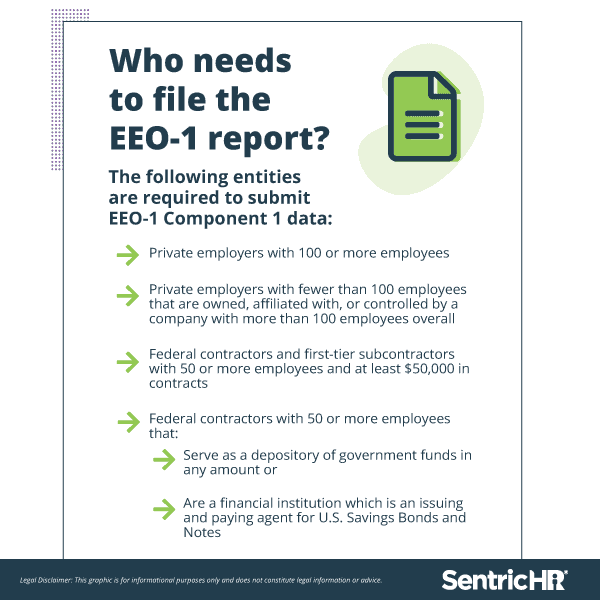Key Points about EEO-1 Component 1 data collection:
- Eligible employers are required to file the EEO-1 report each year. This report gathers employment data to identify workplace discrimination and employment trends.
- The Equal Employment Opportunity Commission (EEOC) will start collecting 2019 and 2020 EEO-1 Component 1 data on April 26, 2021. The final deadline to submit your report is October 25, 2021.
- You can prepare by registering (if applicable) and beginning to gather the appropriate information.
Each year, the EEOC requires eligible employers to submit the EEO-1 report. This report asks employers to group their workforce by race, ethnicity, gender, and job category.
In 2020, the EEOC delayed the collection of 2019 Component 1 data due to the COVID-19 pandemic. They recently announced that they will begin collecting 2019 and 2020 Component 1 data on April 26, 2021.
Below, we answer some FAQs regarding the EEO-1 report and the deadlines for 2021.
What is the EEO-1 report?
The EEO-1 report records employment data that eligible employers must submit to the Federal government. The EEOC uses this data to analyze employment patterns and identify minority representation within specific businesses, industries, and regions. The EEO-1 report has two parts: Component 1 and Component 2.
Component 1 provides data regarding employee race, ethnicity, gender, and job category.
Component 2 provides pay data, such as income and hours worked, according to employee race, ethnicity, gender, and job category.
At this time, the EEOC has suspended collection of Component 2 data. Most employers no longer need to gather this information.
However, California employers are the exception. California employers with 100 or more employees must submit pay and hours-worked data by establishment, job category, sex, race, and ethnicity to the Department of Fair Employment and Housing (DFEH) by March 31, 2021. If you’re a California employer, please click here to learn more about this requirement.
Who needs to file the EEO-1 report?
The following entities are required to submit EEO-1 Component 1 data:
- Private employers with 100 or more employees
- Private employers with fewer than 100 employees that are owned, affiliated with, or controlled by a company with more than 100 employees overall
- Federal contractors and first-tier subcontractors with 50 or more employees and at least $50,000 in contracts
- Federal contractors with 50 or more employees that:
- Serve as a depository of government funds in any amount or
- Are a financial institution which is an issuing and paying agent for U.S. Savings Bonds and Notes
What data do I need to file an EEO-1 report?
To complete the EEO-1 report, you must gather employment data for both part-time and full-time employees. You will need to provide the following information in your EEO-1 report:
- Whether you’re a single or multi-establishment employer
- If you’re a single establishment employer, you only need to file the Standard 100 Form
- If you’re a multi-establishment employer, you may need to submit additional reports: a report for the office headquarters, a separate report for each branch with 50 or more employees, and a consolidated report with all employees who work at branches with less than 50 employees
- The total number of reports you’re filing
- Information about your company (name, address, etc.)
- Your Employer Identification Number (EIN)
- The total number of employees for each job category, race, ethnicity, and gender
- The previous year’s total for each category
- The pay period you used to gather this data
- Your signature
- Your contact information
You can get started and find more information here.
How do I file an EEO-1 report?
- First, determine whether you’re required to file.
- If you are, and you have not filed before, register as a first-time filer. If you’re unsure whether you’re required to file or whether your company is already registered, visit the EEOC’s website.
- After registering, collect the data you need to submit your EEO-1 report.
- Once you’ve gathered this information, file your completed report online through the EEO-1 Online Filing System by the deadline.
The EEOC greatly prefers the online method, but they may accept other formats. If you must submit your report in a paper format, please contact the EEOC Employer Data Team by phone at 1-866-286-6440 or via email at E1.TECHASSISTANCE@EEOC.GOV.
- After you file, keep your records and a copy of your EEO-1 report for at least one year.
When does Component 1 collection open? When is the deadline to submit the EEO-1 report?
The EEOC will begin collecting 2019 and 2020 EEO-1 Component 1 data on April 26, 2021. The final deadline for submitting 2019 and 2020 EEO-1 Component 1 data is October 25, 2021. This was extended from the previous deadline of July 19, 2021.
How can an HRIS help?
An HRIS like SentricHR can help you easily collect and categorize the information you need to complete your EEO-1 report. To learn more about how SentricHR can help simplify your reporting process, contact one of our product experts today!









